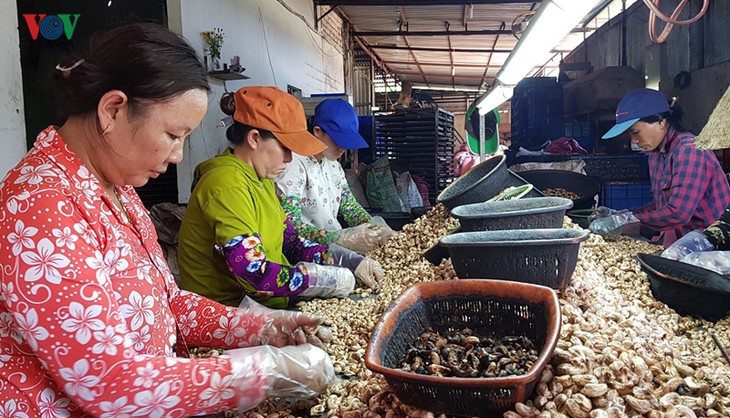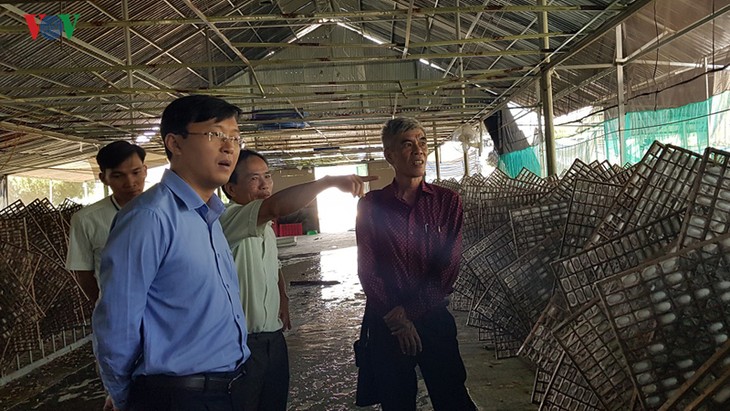(VOVWORLD) - The Phuoc Cat commune in Lam Dong Province has done well in raising cattle and making brocades and wine for tourism. In 2015, Phuoc Cat was recognized as a role model in the movement of new-style rural development. We will tell you more about the changes in the ethnic minority-inhabited Phuoc Cat commune.

The cashew nut processing workshop of Le Van Bay, Director of the Le Gia Trade and Service Cooperative.
|
Since 2005 Phuoc Cat has no longer suffered flooding thanks to the hydroelectric system on Dong Nai River regulating water during the rainy season. The system has helped the locals grow industrial crops and fruit-trees, especially wet rice on alluvial deposit areas along the river banks.
Phuoc Cat is now a rice production center and famous for “Cat Tien Rice,” a brand certified by the National Office of Intellectual Property of Vietnam under the Ministry of Science and Technology.
Le Van Bay, Director of the Le Gia Trade and Service Cooperative, said in 1982 he was one of the first to migrate from Binh Dinh to Phuoc Cat and settle down there.
Over the past 35 years, Bay has made a fortune starting from scratch. In recent years, he has transitioned to providing services and trading. His Le Gia Cooperative grows seedlings, supplies agricultural materials, and collects and processes cashew nuts for export. As of the beginning of this year, Le Gia Cooperative has purchased more than 600 tons of cashews from local farmers. Bay has created jobs for 80 laborers, providing them with stable income.
“I feel a bit luckier than other members in the cooperative so I think I should have the responsibility of helping our colleagues and villagers. The cooperative has 120 workers at maximum with an average monthly salary of more than 190 USD for each person,” Bay said.
Another role model from the area is Nguyen Van Thinh, Director of Phuoc Cat Agriculture Cooperative. Established in 2010 from a small husking workshop, at present Thinh’s cooperative is a rice processor with a yearly capacity of 18,000 tons. In the first half of this year, it provided nearly 10,000 tons of Cat Tien-branded rice. His pig farm sells eight tons of pork each month, with a revenue of nearly 2,200 USD.
Thinh has also become a notable philanthropist in Cat Tien district. He has created sources of capital and jobs for villagers, particularly war veterans, thereby helping them to escape poverty.
Over the past two years, Thinh has developed a new production model to grow strawberry and mulberry trees on 12 ha of land.
He said: “Once the mulberry raising model becomes efficient, we will expand its scale and create more jobs. With its establishment, we have generated jobs for locals with an attractive salary and have thus received a great deal of their support in developing the cooperative.”
 Mulberry farm of Nguyen Van Thinh. Mulberry farm of Nguyen Van Thinh. |
Vo Trung Linh, Chairman of Phuoc Cat town People’s Committee, said last year the local per capita income was more than 2,000 USD a year. This year it is expected to reach nearly 2,200 USD. At present, the income is mainly from agricultural production, especially the production and supply of seeds and specialty rice, said Linh.
“We plan to reduce the proportion of agriculture in the economic structure. We will develop the service sector. With the potential for tourism development, Lam Dong authorities aim to help Phuoc Cat open a tour of the Cat Tien archaeological site, Zone 6 Party Committee Base, and the Phuoc Cat Pagoda.”
In the middle of last year, Phuoc Cat was redistricted to share its border with Lam Dong, Dong Nai, and Binh Phuoc provinces.
Nguyen Hoang Phuc, Deputy Chairman of Cat Tien People's Committee, said: “Phuoc Cat has ample resources to develop agriculture, trade and services as required by new-style rural development. With a large area of riverside alluvial soil, Phước Cát is suitable to grow wet rice, strawberry and fruit trees and has been asked to focus on crop conversion and intensive farming to increase productivity. In regards to the development of trade and services, Phuoc Cat has favorable conditions to trade goods and process cashews and rice.”
Phuoc Cat commune has seen positive changes with emerging models in raising cattle and mulberry, together with the fashioning of brocade and the establishment of wineries for tourism services, especially in ethnic minority-inhabited hamlets.